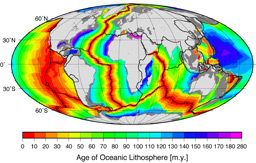Around 150 million years ago, plankton floated in warm seas. Using energy from nuclear reactions in the Sun, they built their bodies from protein and fat and carbohydrate. Then they died and their bodies sank to the muddy sea floor. Over time, the mud was buried, compressed and cooked, and the plankton bodies became an oily liquid. Much later, the liquid was pumped, refined and sold.
Now the liquid is exploding, releasing heat and gas. The gas expands and turns a turbine. The turbine sucks air through the engine and pushes it out into the atmosphere behind. The atmosphere pushes back with an equal force, driving forward the engine and the wing that it is attached to.
The wing has an asymmetric shape that Deflection of air by the wing forces the air passing over it travel faster than the air that passes below. The air below presses on the wing with more force than the faster-moving air above, lifting up both the wing and the metal tube to which it is attached. The metal tube, and the seats inside, travel at 900 kilometres per hour across the ocean.
And the ocean, which is over 3000 km wide and averages ~4000 m deep, didn’t even exist back when the plankton were catching the rays.

Map of the age of the ocean floor. Most of the floor of the Atlantic Ocean is less than 100 million years old. Much of the source rock for North Sea oil was formed in the Jurassic (145-200 million years ago). Image from National Oceanic and Atmospheric Administration (http://www.ngdc.noaa.gov/mgg/ocean_age/). Click for for large version.


Pingback: Stuff we linked to on Twitter last week | Highly Allochthonous
Obligatory XKCD comic
http://xkcd.com/803/
Apart from that, nice article. 🙂
Hmmm, well if you were sure that your Jet-A1 is made from Brent (blend) oil, sourced form the Kimmeridge, then you’re OK – 150Ma is a good enough number for the deposition of the carbon. Cooking though … sorry, “maturation”, why use a short word when a long one will do? … is rather more recent, and possibly/ probably post-dates the Palaeocene-Eocene NW Europe volcanism that marked the opening of the Atlantic (and may well have triggered the PETM “blast in the past” so feared by anti-climate change idiots). You’re probably OK if you’re flying from the UK to America.
Flying the other way, you may be using Gulf of Mexico oil … which is generally newer. Eocene to Oligocene, maybe newer. I don’t do American oil, yet.
On the other hand, if you follow Tom Gold’s “primordial methane” hypothesis, then if you’re flying over the Acasta Gneiss you’re flying on oil older than the landscape. And if you believe Tom Gold, then there is a bridge salesman who wants to talk to you.
/pedant mode
“The turbine sucks air through the engine and pushes it out into the atmosphere behind. The atmosphere pushes back with an equal force, driving forward the engine and the wing that it is attached to.”
Ummm not really. The reaction force that propels a turbine engine is the same one that propels a rocket (which, of course, works *best* in a vacuum, with no atmosphere to ‘push back’), or indeed a balloon with an untied neck flying around a room.
It’s the *internal* reaction within the engine, which is full of compressed gas. This gas exerts force against the inside of the engine in all directions. But the force against the front of the engine – against the rear of the fan or compressor – is *unbalanced* by any opposite force to the rear, because the exhaust is open.
The atmosphere doesn’t ‘push back’ against anything.
There’s a little diagram here which makes it clear:
http://www.grc.nasa.gov/WWW/k-12/BGP/balloon2.gif
Mike